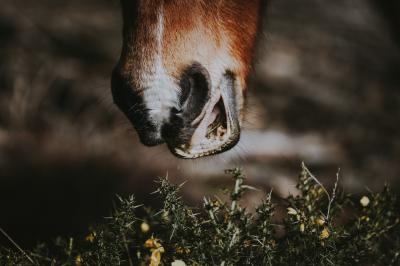
Many horses are enjoying time outdoors right now, which means we need to be extra careful about the dangers posed by poisonous plants.
Horses usually avoid them, but if there’s a shortage of grass in their field, they may turn to these dangerous plants to keep them full.
Correct field management and daily checks are important. It is also important to be aware of the symptoms of poisoning, as leaving your horse untreated could prove fatal.
The most common poisonous plant affecting horses in the UK is ragwort. It is often found on waste land and areas of unmanaged pasture and spreads easily.

Horses normally avoid eating ragwort because it is bitter, but it is much more palatable when it is dried in hay. Once eaten, ragwort will attack the horse’s liver and cause severe illness.
Early signs of ragwort poisoning include weight loss despite good appetite, depression, low-grade colic and yellow discolouration of the gums.
In cases where severe damage to the liver has occurred, the horse may show signs of neurological disease such as a lack of coordination, circling and blindness.
There’s no specific treatment that will cure the disease or reverse the damage to the liver. However, if the poisoning is identified at an early stage supportive therapy can allow the liver to regenerate.
Remove the plant from grazing land including any roots, to prevent re-growth. Once removed, it should either be burned or disposed of elsewhere to prevent the seeds from spreading.
A toxin called hypoglycin A is found in the distinctive winged fruits produced by some species of sycamore tree. Hypoglycin A is responsible for atypical myopathy, a severe muscle disorder, which usually presents with sudden onset lethargy, sweating, muscle stiffness, dark urine and difficulty standing.
Affected horses are often found lying down and the condition is easily mistaken for colic. Sadly, atypical myopathy is a fast killer, with a mortality rate of 75-90 per cent.
If caught early, affected horses can be treated with supportive care, such as intravenous fluids and admission to a specialist equine hospital for 24-hour advanced veterinary care. If a horse survives the first few days of treatment, they usually go on to recover completely, although this can take several months. In severe cases, euthanasia has to be considered to prevent further suffering.
The risk can be reduced by preventing horses from ingesting sycamore leaves, seeds and seedlings, fencing off sycamore trees and ensuring horses have access to sufficient supplementary feed, such as hay in the field, to minimise the risk of foraging for alternatives.
Bracken is toxic if eaten in very large amounts over several months. It causes neurological disease but if caught early, thiamine supplementation prescribed by a vet can help the horse make a full recovery.
Foxgloves cause cardiovascular disease which can result in death within a few hours. If you suspect your horse has eaten foxgloves, call your vet immediately as activated charcoal can prevent the toxin being absorbed by the intestine. Like ragwort, foxgloves can remain poisonous even once the flowers have died and dried out, so make sure you buy your hay from a reputable source and don’t allow your horse to graze near compost heaps or garden cuttings.
Acorns can be toxic if eaten in sufficient quantities There’s no specific antidote, though supportive care may be given. In rare cases, acorn poisoning can be fatal because the prognosis is poor if kidney damage develops. It is sensible to prevent your horse having access to large numbers of acorns.